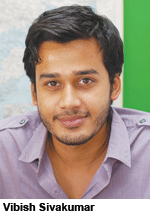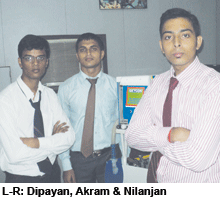 The global acclaim and Golden Globe and Oscar awards won by the feature film Life of Pi which narrates the story of a ship-wrecked Puducherry teenage boy adrift on a lifeboat in the Pacific for 227 days, has transformed Bangalore students Md Abbas Khaleeli (16) and Vibish Sivakumar (23) into minor celebrities in this garden-turned-garbage city. They were selected by celebrated Holly-wood director Ang Lee (Brokeback Mountain, Sense and Sensibility, Crouching Tiger) to play the role of Ravi Patel — the teenage elder brother of Piscine (aka Pi) — from among 4,000 students who auditioned for the brief cameo roles totalling 4.5 minutes in the 127-minute box-office busting movie.
The global acclaim and Golden Globe and Oscar awards won by the feature film Life of Pi which narrates the story of a ship-wrecked Puducherry teenage boy adrift on a lifeboat in the Pacific for 227 days, has transformed Bangalore students Md Abbas Khaleeli (16) and Vibish Sivakumar (23) into minor celebrities in this garden-turned-garbage city. They were selected by celebrated Holly-wood director Ang Lee (Brokeback Mountain, Sense and Sensibility, Crouching Tiger) to play the role of Ravi Patel — the teenage elder brother of Piscine (aka Pi) — from among 4,000 students who auditioned for the brief cameo roles totalling 4.5 minutes in the 127-minute box-office busting movie.
Currently a class XI student of the city’s St. Joseph’s Boys High School (SJBHS), Abbas was a class VIII student when he was picked to play 14-year-old Ravi Patel. “Even though I had a screen presence of only three minutes, shooting with a 70-member international prod-uction crew on locations in Taiwan, Munnar and Puducherry for almost 45 days has been a life-changing exper-ience. I’ve learnt a lot about 3-D cinema and skillful editing of film footage,” says Abbas.
Likewise, an SJBHS alumnus also known in the city’s Toastmasters International circuits for his power-packed public speeches and a recent telecommunications graduate of Bang-alore’s R.V. College of Engineering, the selection to play the 19-year-old Ravi Patel from 3,000 auditioned nationally, has been a defining experience for Vibish. “Initially I had auditioned for Pi but Delhi student Suraj Sharma bagged the role. Of course I was disappointed with the alternate offer to play Pi’s elder brother who dies in the shipwreck, but I accepted anyway,’’ says Vibish.
 Despite a short 1.5-minute screen appearance, Vibish acknowledges that shooting with Ang for over a month was a “mind blowing’’ educa-tive experience. “Ang’s thorough professionalism, and technical application of three dimensional special effects to serve the movie’s artistic vision were truly inspirational,” he enthuses.
Despite a short 1.5-minute screen appearance, Vibish acknowledges that shooting with Ang for over a month was a “mind blowing’’ educa-tive experience. “Ang’s thorough professionalism, and technical application of three dimensional special effects to serve the movie’s artistic vision were truly inspirational,” he enthuses.
After the filming in mid-2011 and acquiring his engineering degree in August the same year, Vibish signed up for a two-month acting course at the New York Film Academy.
With a class X board exam score of 84 percent despite the distractions of shooting for a Hollywood cameo, Abbas has his eyes set on law school after class XII, and has also shortlisted acting as a career option. Ditto Vibish, currently studying for entry into flying school after turning down several job offers from well-known IT companies, who is “more than receptive’’ to film/stage roles.
Clearly, cinema is addictive.
Paromita Sengupta (Bangalore)
Oxy-Con inventors
 Three youths of modest socio-economic backgrounds have developed a new device named Oxy-Con — a non-invasive ventilator — which gives the medical practitioners’ fraternity an option to control oxygen supply administered to patients. The inventors of Oxy-Con are Nilanjan Ghosh (21), Sheikh Akram Ali (22) and Dipayan Jash (21), all final year electronics and communications stud-ents at the MCKV Institute of Engin-eering, a well-respected private college of West Bengal (estb. 1999).
Three youths of modest socio-economic backgrounds have developed a new device named Oxy-Con — a non-invasive ventilator — which gives the medical practitioners’ fraternity an option to control oxygen supply administered to patients. The inventors of Oxy-Con are Nilanjan Ghosh (21), Sheikh Akram Ali (22) and Dipayan Jash (21), all final year electronics and communications stud-ents at the MCKV Institute of Engin-eering, a well-respected private college of West Bengal (estb. 1999).
While Nilanjan’s father, Atanu, is a manager in the biomedical department of A.M.R.I, a private hospital in Kolkata, Dipayan’s sire, Manoj Kumar is a deputy forest range officer and Akram’s father Sheikh Sahajahan Ali a farmer residing in Singur. The trio drew inspiration from Technotica 2012, the annual techno fest of MCKV staged in January last year. “My father who works in a hospital, identified the widespread need for an oxygen flow control device. So we set about finding ways to invent Oxy-Con to present at the techno fest,” says Nilanjan.
The Oxy-Con machine bagged the second prize at Technotica 2012, and the Best Applied Technology Award of the Birla Industrial & Technological Museum, Kolkata. According to its inventors it can supply a controlled flow of oxygen as per each patient’s requirement. “It can be used at home, in nursing homes and hospitals for patients with chronic breathing ailments who require long-term ventilator assistance. The cost of continuous oxygen supply from unregulated cylinders is about Rs.50 per hour. By using Oxy-Con it can be reduced to Rs.17 per hour,” says Akram.
The technical properties of this high-potential invention are elaborated by Dipayan. “The ratio between inhalation and exhalation is 1:2. By shutting off supply during exhalation, Oxy-Con can save large amounts of this life-saving gas,” he explains.
Inspired by the prize money — a modest Rs.7,000 from the two techno fests — the threesome who also share a passion for cricket, football and music, are bitten by entrepreneurship. “Indian industry and the economy needs hundreds of time and money-saving inventions. By identifying need gaps and applying the knowledge we acquire in science and technology higher education, it is entirely possible to build large businesses,” says Nilanjan.
Wind beneath your wings!
Baishali Mukherjee (Kolkata)